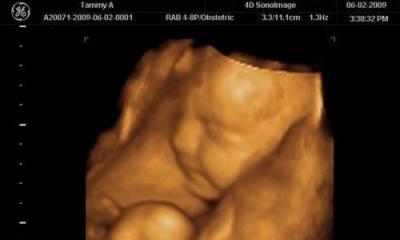24 weeks of pregnancy (according to the obstetric calendar, this is the end of the sixth month) is an important stage in bearing a child. The fetus is not yet fully formed, but if premature birth occurs, the chance of saving the baby's life at this gestational age is very high.
Despite the fact that the stomach at week 24 is already quite large, many women remember this period as the most carefree. This stage of gestation is optimal for the future woman in labor to calmly prepare everything necessary for meeting with the long-awaited child, because by this time his gender is already becoming known.
Baby development at 24 weeks pregnant
At the 24th week of pregnancy, the active formation of the internal systems and organs of the fetus continues. During this period, he often moves, which brings a lot of happy moments to a woman, inspires calmness and confidence that everything is in order with the baby.
Every couple who is expecting the birth of a desired child is interested in what happens to him at the twenty-fourth week of pregnancy, how he looks, how much he weighs and how tall he is at this stage of gestation.
Child size and weight
A feature of the 24th week of gestation is that during this period the embryo begins to independently produce growth hormone. At this time, the average weight of the child is 600 g, height - 30 cm. In order for future parents to be able to imagine the size of the baby at the 24th obstetric week of pregnancy, the parameters of children at this age are compared with the average ear of corn.
What happens to the baby in the womb?

After 23 weeks of gestation, the baby's body in the womb undergoes the following changes:
- Thanks to the active development of internal organs and systems, the baby's face acquires a pretty and symmetrical shape. His appearance becomes more and more similar to that of newly born children. Wrinkles on the face and body are softened.
- Red skin tone gradually turns pink.
- The accumulated subcutaneous brown fat, which is responsible for keeping warm, protects the fetus from hypothermia in conditions of the thermoregulation system that has not yet been fully formed.
- At the 24th week of gestation, the fetus ends with an active increase in the brain (by this time, the final number of nerve cells has already been formed in it). The first furrows and convolutions appear on the surface.
- By the end of the 6th month of pregnancy, sebaceous and sweat glands are formed.
- By the beginning of the 25th week of gestation, the formation of the genital organs has already been completed (in girls - the uterus, vagina and fallopian tubes, in boys - the penis and scrotum.) In the ultrasound photo, which is prescribed at this time only if there are medical indications, it is already possible to accurately determine gender of the unborn child.
- By the end of the second trimester from the moment of conception, the baby already has a well-developed vestibular apparatus. Thanks to this, he picks up sounds and is even able to distinguish the emotionally expressive coloring of speech. The reaction of the fetus to music, the tone and sound of the voice is expressed in the form of movements.
- At the 24th week of pregnancy, the respiratory system is formed so that in case of premature birth and with the implementation of the necessary resuscitation measures, the child can breathe on his own.
- At this time, the accumulation of meconium continues and the production of enzymes by the liver and pancreas responsible for the digestion of breast milk continues.

The beginning of the sixth month of pregnancy is marked by the fact that during this period a tactile contact is established between the mother and the baby, who already feels the touch of the mother's hands on the parts of his body protruding through the stomach. The facial expressions of the baby are so developed that in the video that many future parents shoot during the ultrasound, you can clearly see how he squints, opens his mouth, smiles and yawns.
How is the fetus located?
Due to the fact that the outcome of pregnancy largely depends on how the child is located in the womb of the future woman in labor, this moment worries almost every pregnant woman. At the twenty-fourth week of gestation, the crumbs already have their own ideas about comfort, so he independently changes the position of the body and is located in the uterine cavity as it suits him. In most cases, at 24 weeks, the fetal head looks down - this is the correct intrauterine position.
Crossed arms and legs are tightly pressed to the body, and the chin to the chest. If at this stage of development the baby takes the wrong position, later he can still roll over, because only twenty-four weeks have passed since conception and his weight is not yet so great that he was not able to move in the womb.
The condition of the expectant mother and changes in her body
At the 24th week from the moment of conception, not only children's organs and systems are subject to changes. During this period, the body of a woman also changes. How much does the uterus weigh on average at this stage of pregnancy? What kind of pain can a future woman in labor experience? How often does the fetus move if it is the 24th week of gestation? What is the psycho-emotional background of pregnant women in this period?
Enlargement of the uterus
The less time left before childbirth, the greater the transformation undergoes the uterus of the expectant mother. By the beginning of the 24th week of gestation, the weight of the baby is actively increasing, which entails an increase in the size of the uterus. As a result of this, its position is shifted 4-5 cm above the navel or 24 cm from the womb to the uterine fundus.
Along with this, the uterus undergoes other changes:
- the walls are stretched;
- increased uterine tone;
- training contractions periodically occur - painless contractions of the uterus, designed to prepare it for childbirth;
- the gradual formation of a mucous plug begins;
- the volume of amniotic fluid increases to 400 ml.

Pain and discharge
After 23 weeks of gestation, the future woman in labor experiences mostly pleasant moments. The inevitable weight gain and hormonal changes in the body may be accompanied by:
- Leg pain and muscle cramps. The cause of these symptoms in most cases is a lack of calcium and magnesium. Taking vitamin complexes containing these components, warm foot baths, massage and stretching will help to cope with this problem. Compression of the inferior vena cava as a result of an increase in the size of the uterus can also lead to the development of pain syndrome. In this case, it is useful to lie with your legs up as often as possible.
- Pain in the abdomen, arising from prolonged exposure to an uncomfortable position, which leads to stretching of the ligaments of the uterus. To alleviate the condition, it is enough to lie on your left side, tucking your legs as close to your stomach as possible.
- Problems with digestion and violation of the process of emptying the intestines.
- Migraine.
- Slight discomfort in the lumbar region.
- Excessive sweating.

Normal discharge at this stage of gestation should be light, clear or whitish. If bloody inclusions are visible, an unpleasant pungent odor and a specific shade (green, brown, rich yellow) appear, you should immediately consult a doctor.
fetal movement
As a result of weight gain, the future woman in labor already clearly feels the movements of the baby in her stomach. During this period of gestation, the motor activity of the fetus is characterized by dynamism. Despite the fact that its size is no longer quite small, it actively turns over in the womb and constantly changes positions. Movement of the arms and legs, pushing away from the walls of the uterus, as well as touching the umbilical cord often cause pain to a woman.
Most of the day (about 20 hours) the baby sleeps. On average, a baby in the womb makes about 15 movements every hour. The expectant mother should not be disturbed if he calmed down for a few hours. If the movements have stopped for more than 12 hours, this is a reason for an urgent appeal to the attending physician.
The optimal weight of a pregnant woman at 24 weeks

The weight gain of a future woman in labor at each stage of gestation depends on the type of her figure. In women with an asthenic physique, as a rule, this figure is small.
The optimal weekly weight gain during pregnancy is 300-500 g. Normally, in a pregnant woman with a normal build, weight gain by the end of the second trimester should be 8 kg.
Women with a large and massive physique during the bearing of the baby must carefully monitor the weight gain. For this, it is recommended to weigh yourself daily. Experts note that during gestation it is better to gain little than too much. Large weight gain can not only worsen the condition of the expectant mother, but also significantly complicate the birth process.
The psycho-emotional state of a woman
By this stage of pregnancy, most of the experiences are already behind, and the woman can completely surrender to new sensations. The sixth month of pregnancy is the best time to enjoy motherhood. With every movement of the child, the heart of the expectant mother is filled with joy and anticipation of meeting with the desired baby.
The attitude of husbands during this period in most cases changes and becomes more reverent. Future dads, in an attempt to hear and feel the movements of their son or daughter, like to put their hand or ear to their wife's tummy. These incomparable feelings are a sign of the unity of two adults, the result of whose love will soon be born.

Along with positive emotions, many future women in labor at this stage of gestation experience frequent mood swings against the background of hormonal changes. A woman during this period can also be visited by anxiety and doubts about whether she can cope with a new role, whether she will become a good mother. Experts recommend that pregnant women fight despondency and avoid negative emotions - the suffering of the expectant mother can negatively affect the development of the fetus.
Diet and daily routine of a pregnant woman
Doctors during this period of gestation give pregnant women the following recommendations regarding nutrition and daily routine:
- adhere to fractional nutrition;
- organize the diet in such a way that 30% of the menu is vegetables and fruits, 70% cereals, dairy, meat and fish products;
- give preference to seasonal vegetables and fruits;
- do not drink tea immediately after eating, otherwise the substances contained in it will impair the absorption of iron;
- exclude fatty, pickled and spicy foods from the diet;
- reduce salt intake;
- drink at least one and a half liters of water daily;
- refuse shoes with high heels;
- before going to bed, take a contrast shower - this procedure has a beneficial effect on the state of blood vessels and allows you to cope with swelling;
- instead of long walks, overloading the legs, rest on a bench in the park;
- daily yoga, swimming or gymnastics for pregnant women;
- several times a day to actively strain and relax the muscles of the vagina.

Intimate life of parents
Sex during this period can bring many new sensations into the intimate life of spouses, because the future woman in labor, due to the changes taking place in her body, is able to experience vivid multiple orgasms. However, safety precautions should be observed, namely avoided.








